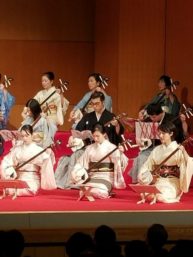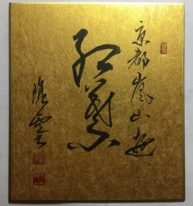This semester, I continued my koto lessons from last semester. It all started with my first ever performance with all the rest of my teacher’s students, numbering around 50 people total. The recital was 2 parts: first, various songs performed by different groups of students, and second, 3 songs that featured her. It was a loooooong night – the rehearsal was at least 6 hours, and the performance itself was around 3 total. But, it was a fun experience, especially since I can tell people that I performed “Let it Go” in an ensemble of traditional Japanese instruments. I also got to meet lots of interesting people, including a geiko, my teacher’s very old mother, and even a nice fellow who took me on a date and bought me socks! After that performance, I took a short break from rehearsing, and went back after a few weeks to discover my technique had deteriorated greatly. The solution to this was to, in theory, practice 2-3 times a week, but due to my health and business I averaged once a week… oops! However, I quickly relearned what I had forgotten and began practicing new music to perform at the closing ceremony for KCJS.
After one semester of practicing, I considered switching my CIP – having performed, it was the perfect time to make my leave. However, my teacher was so sweet that I couldn’t resist when she asked if I was willing to keep practicing with her. Furthermore, she invited me to lots of random outings – such as visiting cherry blossoms and seeing random performances around the city. We actually texted decently often, which at one point resulted in an embarrassing but funny texting interaction on March 2nd (3月2日, the Japanese is important here) that reminded me not to misread 4月 as 4日:
Her: “Benji, I know a good spot to see the blossoms around April (4月), would you like to go see?”
Me: “Sure, class ends at 11:30 so I’m free after that!” [I was thinking she said 4日]
Her: “…Right… Don’t your classes end around the 20th of April…?”
[LATER, ON 4日]
Me: “I believe so!”
Me: “Today it’s raining… what will you do?”
Me: “Oh, whoops… I misunderstood”
Me: “Nevermind”
Her: “It is raining today, but what will we do…?”
My friends and I all had a good laugh about my incompetence at reading kanji, though I never asked her what she made of that interaction.
Overall, I enjoyed my CIP this semester just as much as last semester. After working with my teacher for so long, we definitely reached a level of comfortability such that I never felt nervous going to practice like I did last semester. Furthermore, my skill has improved to a level that I can actually feel proud of – enough that I plan to look for koto teachers once I go back to America! For anyone considering doing instrument lessons at all, I urge them to do the full year if possible. It really is worth the investment to practice with someone for a full year!


